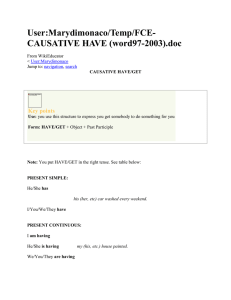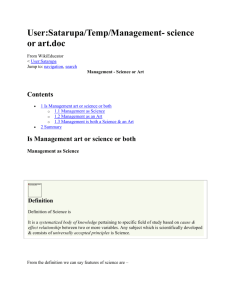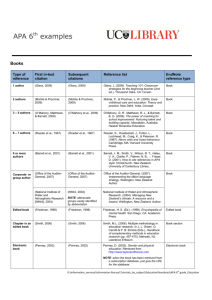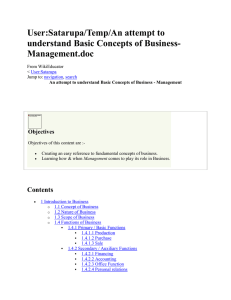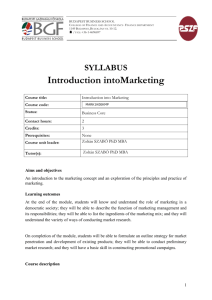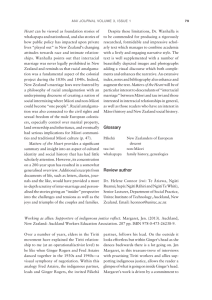User:Jan Ferguson/Temp/Time use handout 2
advertisement
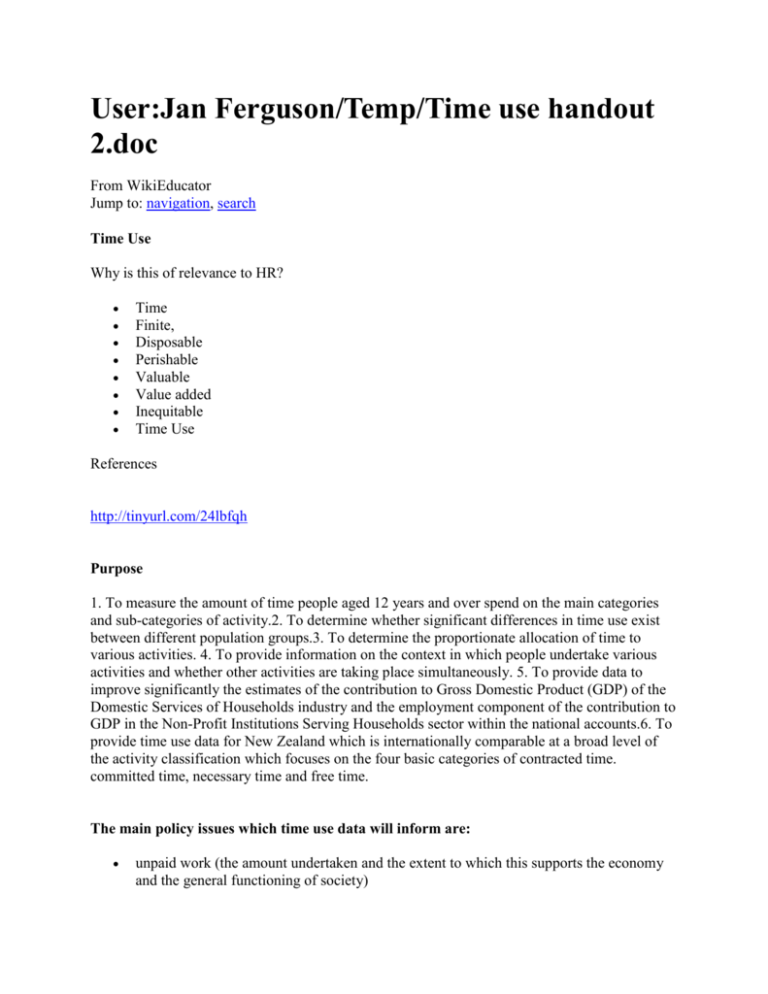
User:Jan Ferguson/Temp/Time use handout 2.doc From WikiEducator Jump to: navigation, search Time Use Why is this of relevance to HR? Time Finite, Disposable Perishable Valuable Value added Inequitable Time Use References http://tinyurl.com/24lbfqh Purpose 1. To measure the amount of time people aged 12 years and over spend on the main categories and sub-categories of activity.2. To determine whether significant differences in time use exist between different population groups.3. To determine the proportionate allocation of time to various activities. 4. To provide information on the context in which people undertake various activities and whether other activities are taking place simultaneously. 5. To provide data to improve significantly the estimates of the contribution to Gross Domestic Product (GDP) of the Domestic Services of Households industry and the employment component of the contribution to GDP in the Non-Profit Institutions Serving Households sector within the national accounts.6. To provide time use data for New Zealand which is internationally comparable at a broad level of the activity classification which focuses on the four basic categories of contracted time. committed time, necessary time and free time. The main policy issues which time use data will inform are: unpaid work (the amount undertaken and the extent to which this supports the economy and the general functioning of society) paid employment (the relationship between different uses of time and the factors which hinder or help people's participation in the paid work force) health (the amount of "caring" work done in New Zealand and the activities people do which impact on health status) income support (the use of time by recipients of government income support) education and training (how much is being undertaken and by whom) Mäori (use of time by Mäori people, differences in time use from the wider population, and factors which may impede Maori's full participation in various types of social and economic act What is time? Types of timeAggregations of activity groups to four major categories of time, as below:Necessary time = 01 Personal care Contracted time = 02 Labour force activity, plus03 Education and training Committed time = 04 Household work, plus05 Caregiving for household members, plus06 Purchasing goods and services for own household, plus07 Unpaid work outside of the home Free time = 08 Religious, cultural and civic participation, plus09 Social entertainment, plus10 Sports and hobbies, plus11 Mass media and free time activities Why Measure time? Rudman reminds us: About the impact of F.W. Taylor’s work – time study. Developed further by the Gilbreths’ – motion study Fordism – the moving assembly line Why Measure time/ Work simplification Productivity Rotation to increase productivity by 20% Why Measure time? Rudman quotes Asplund managers do not take action to improve working conditions, improve health and safety. Or improve quality of working life unless they are convinced that there will be an adequate return on the time and money invested in such measures……… Why Measure time? Impact on pay o o o o o Base pay; rate of pay based on units of output and units of time Earnings based on time spent at work Earnings based on time to get the skill or qualification Flexitime Why Measure time? Time based pay Most common method Constant and predictable income Performance not always fair measure Efforts not always good indicator – e.g. mechanised work. Equitable – conflict resolution Why Measure time? Dessler uses time in a Time series graph to assess impact of a Training programme. Metrics o Reaction (immediate time) o Test learning and transferability (immediate and short term) o Behaviour changes: output, satisfaction (long term) o Results: less complaints , more productivity o Time and Culture Milmore Lewis et al refer to time as a differential in culture following the work of Hofstede: o Long-term, short term orientation o Critical in terms of decision making o E.g. investment in training – Japan has focus on the future – long term whereas western countries focus on short term – company results. Time and Culture Task 1. Read the excerpt from Usunier (2005) pp 24 – 29 Is time a tangible commodity and if so how does this affect the way it is regarded and managed by HR. 2. What are monochronic and polychronic uses of time - suggest uses to HR 3. What is linearity and cyclicity and suggest uses to HR 4. Suggest the uses to HR of temporal orientations 5. Suggest the uses to HR of Makimono time Time Use Survey - Uses http://tinyurl.com/23hnsh6 Task Evaluate the information in the document. Which information; o would you use to guide your recruitment strategies would you use in reward strategies would be useful in guiding job design would be useful in differentiating you as an employer of choice would be essential to you as an international HR director References Dessler, G., Griffiths, J., & Walker, B. L.-. (2008). Human Resource Management (3 ed.). Frenchs Forest: Prentice Hall Hofstede, G. H. (2001). Culture's consequences : comparing values, behaviors, institutions, and organizations across nations (2nd ed.). Thousand Oaks, Calif.: Sage Publications. Millmore, Lewis, Saunders, Thornhill, & Morrow. (2007). Strategic Human Resource Management Contemporary Issues. Essex: Prentice Hall Rudman, R. S. (2002). Human resources management in New Zealand (4th ed.). Auckland, N.Z.: Prentice Hall. Usunier, J.-C., & Lee, J. (2005). Marketing across cultures (4th ed.). Harlow, England: Financial Times Prentice Hall. Retrieved from "http://wikieducator.org/index.php?title=User:Jan_Ferguson/Temp/Time_use_handout_2.doc&ol did=533330" Navigation menu Personal tools Log in Request account Namespaces User page Discussion Variants Views Read View source View history Actions Search Search Go Navigation Main Page Recent changes Help Practice editing Community Community portal Web chat Mailing list Print/export Create a book Download as PDF Printable version Tools What links here Related changes User contributions Logs Upload file Special pages Permanent link Page information This page was last modified on 22 April 2010, at 02:03. This page has been accessed 85 times. Content is available under the Creative Commons Attribution Share Alike License unless otherwise noted. Privacy policy About WikiEducator Disclaimers
